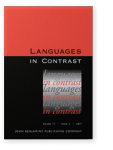Motivating an English-German contrast in word-formation
German has a set of nouns which are derived from a combination of a preposition and the reciprocal pronoun einander ‘one another’. Compounds of this type are strikingly absent from English, although all the components that enter the German formations are available in English, as well. This paper takes a closer look at the relevant word-formation patterns, focusing on compounding and different types of conversion, also taking into account the diachrony of reciprocal pronouns (einander in German and each other/one another in English) and the role of morphological schemas. It will be argued that for explaining the lack of English nouns corresponding to the German nouns under discussion contrasts in the history and the grammar of reciprocals are less relevant than (i) the availability of well-entrenched word-formation patterns, and (ii) the more significant role of ‘syntactic conversion’ in German.
Article outline
- 1.Introduction
- 2.Word-formation in English and German
- 2.1Compounding
- 2.2Conversion
- 2.3Problems of delimitation
- 3.The status of PREP-einander nouns
- 3.1The case of Miteinander, Nebeneinander and Durcheinander
- 3.1.1Semantics
- 3.1.2Morphosyntax
- 4.Explaining the contrast
- 4.1Scenario 1: Contrasts in the expression of reciprocity
- 4.2Scenario 2: Schemas
- 5.Discussion: PREP-einander compounds and English-German contrasts in word-formation
- 5.1Conversion
- 5.2Compounding
- 6.Summary
- Acknowledgements
- Notes
-
References
References (39)
Bauer, L.
1983 English Word-formation. Cambridge: Cambridge University Press.


Bauer, L.
2011 Compounds and minor word-formation types. In
The Handbook of English Linguistics,
B. Aarts and
A. McMahon (eds), 483–506. London: Blackwell.

Berg, T.
1998 The incompatibility of morpheme orders and lexical categories and its historical implications.
English Language and Linguistics 21: 245–262.


Berg, T., Helmer, S., Neubauer, M., and Lohmann, A.
2012 Determinants of the extent of compound use: A contrastive analysis.
Linguistics 501: 269–303.


Booij, G.
2010 Construction Morphology. Oxford: Oxford University Press.

Botha, R.
1981 A Base Rule Theory of Afrikaans Synthetic Compounding. In
The Scope of Lexical Rules,
M. Moortgat,
H. v.d. Hulst and
T. Hoekstra (eds), 1–77. Dordrecht: Foris.

Bybee, J.
2010 Language, Usage and Cognition. Cambridge: Cambridge University Press.


Carstairs-McCarthy, A.
2002 An Introduction to English Morphology. Edinburgh: Edinburgh University Press.

Donalies, E.
2011 Basiswissen deutsche Wortbildung. Tübingen: Francke.

Dudenredaktion
2000 Duden: Die deutsche Rechtschreibung, 22nd ed. Mannheim: Dudenverlag.

Dudenredaktion
2005 Duden: Die Grammatik, 5th ed. Mannheim: Dudenverlag.

Eisenberg, P.
2004 Grundriss der deutschen Grammatik: Das Wort, 2nd ed. Stuttgart: Metzler.


Erben, J.
2006 Einführung in die deutsche Wortbildungslehre, 6th ed. Berlin: Erich Schmidt Verlag.

Eschenlohr, S.
1999 Vom Nomen zum Verb: Konversion, Präfigierung und Rückbildung im Deutschen. Hildesheim/Zürich/New York: Georg Olms Verlag.

Fischer, O.
2007 Morphosyntactic Change: Formal and Functional Perspectives. Oxford: Oxford University Press.

Fleischer, W. and Barz, I.
2012 Wortbildung der deutschen Gegenwartssprache, 4th ed. Berlin: de Gruyter.


Gast, V.
2008 V-N compounds in English and German.
Zeitschrift für Anglistik und Amerikanistik 561: 269–282.


Gast, V. and Haas, F.
2008 On reflexive and reciprocal readings of anaphors in German and other European languages. In
Reciprocity and Reflexivity Theoretical and Typological Explorations,
E. König and
V. Gast (eds), 307–346.Berlin: de Gruyter.

Grimm, J. and Grimm, W.
1854–1961 Deutsches Wörterbuch. Leipzig.

Haas, F.
2010 Reciprocity in English: Historical Development and Synchronic Structure. London: Routledge.

Haselow, A.
2011 Typological Changes in the Lexicon: Analytic Tendencies in English Noun Formation. Berlin: de Gruyter.


Hiltunen, R.
1983 The Decline of the Prefixes and the Beginning of the English Phrasal Verb: The Evidence from some Old and early Middle English Texts. Turku/Helsinki: Turun Yliopiso.

Kastovsky, D.
2006 Vocabulary. In
A History of the English Language,
R. Hogg and
D. Denison (eds), 199–270. Cambridge: Cambridge University Press.


Koehn, P.
2005 Europarl: A parallel corpus for statistical machine translation.
MT Summit 51: 79–86.

König, E. and Gast, V.
2012 Understanding English-German Contrasts, 3rd ed. Berlin: Erich Schmidt Verlag.

Lieber, R.
2009 IE, Germanic: English. In
The Oxford Handbook of Compounding,
R. Lieber and
P. Stekauer (eds), 357–369. Oxford: Oxford University Press.

Lohde, M.
2006 Wortbildung des modernen Deutschen. Tübingen: Narr.

Marchand, H.
1969 The Categories and Types of Present-day English Word Formation. München: Beck.

Oxford English Dictionary
Available online at
[URL] [last accessed 2 June 2016]
Plank, F.
2008 Thoughts on the origin, progress, and pro status of reciprocal forms in Germanic, occasioned by those of Bavarian. In
Reciprocity and Reflexivity Theoretical and Typological Explorations,
E. König and
V. Gast (eds), 347–373.Berlin: de Gruyter.

Schmid, H.-J.
2011 English Morphology and Word-Formation: An Introduction. Berlin: Erich Schmidt Verlag.

Schmid, H.-J.
2015 The scope of word-formation research. In
Word-Formation. An International Handbook of the Languages of Europe. Vol. I1. (Handbücher zur Sprach- und Kommunikationswissenschaft / Handbooks of Linguistics and Communication Science (HSK) 40/1),
P. O. Müller,
I. Ohnheiser,
S. Olsen and
F. Rainer (eds), 1–21. Berlin: De Gruyter Mouton.

Schröder, A.
2011 On the Productivity of Verbal Prefixation in English: Synchronic and Diachronic Perspectives. Tübingen: Narr.

Vogel, P.M.
1996 Wortarten und Wortartenwechsel: Zu Konversion und verwandten Erscheinungen im Deutschen und in anderen Sprachen. Berlin/New York: de Gruyter.


Wiemer, B. and Nedjalkov, V. P.
Cited by (1)
Cited by 1 other publications
This list is based on CrossRef data as of 5 july 2024. Please note that it may not be complete. Sources presented here have been supplied by the respective publishers.
Any errors therein should be reported to them.
